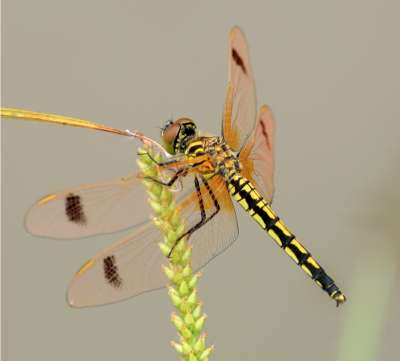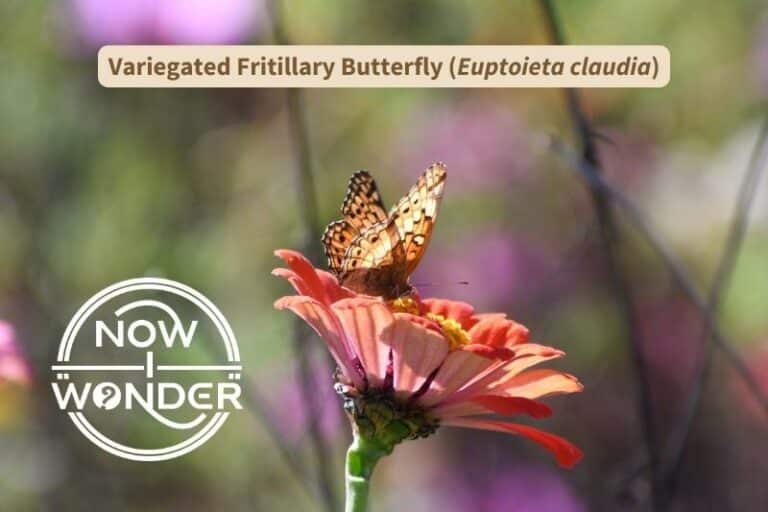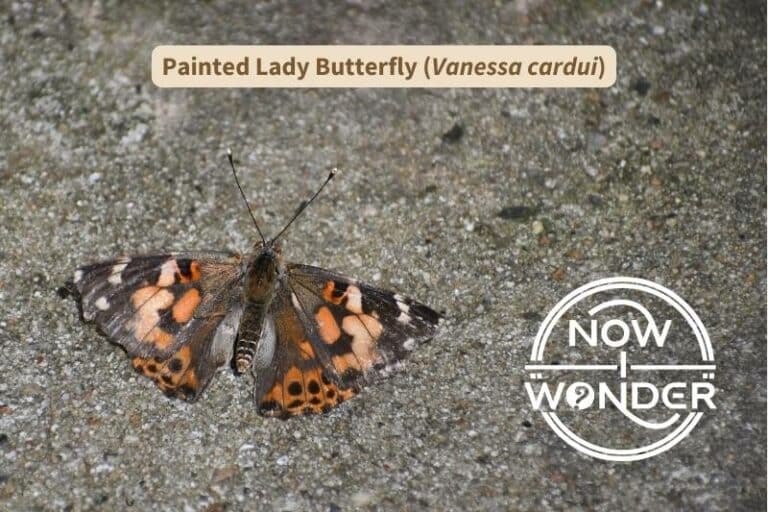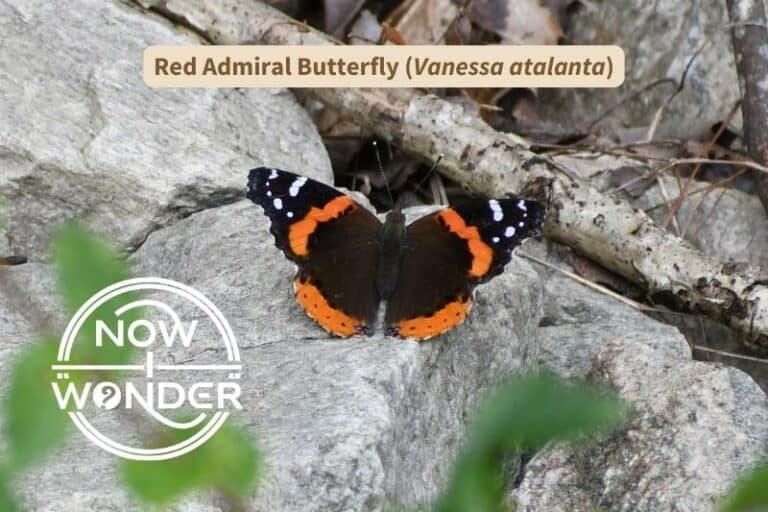The Hop Merchant Comma butterfly (Polygonia comma) lives in North Carolina all year round. But that doesn’t make this species easy to find in the wild.
When perched out in the open, they keep a close watch out for incoming predators and admiring humans and are quick to take flight into the shelter of their forested habitats. They fly quite fast for butterflies and are beautifully camouflaged as dead leaves dangling from the trees to which they flee.
So, it’s tough to spot a wild Hop Merchant Comma butterfly quickly enough to get a good photograph; the photos I’ve included in this post are of a captive Hop Merchant Comma housed in the butterfly enclosure of Airlie Gardens in Wilmington, NC.
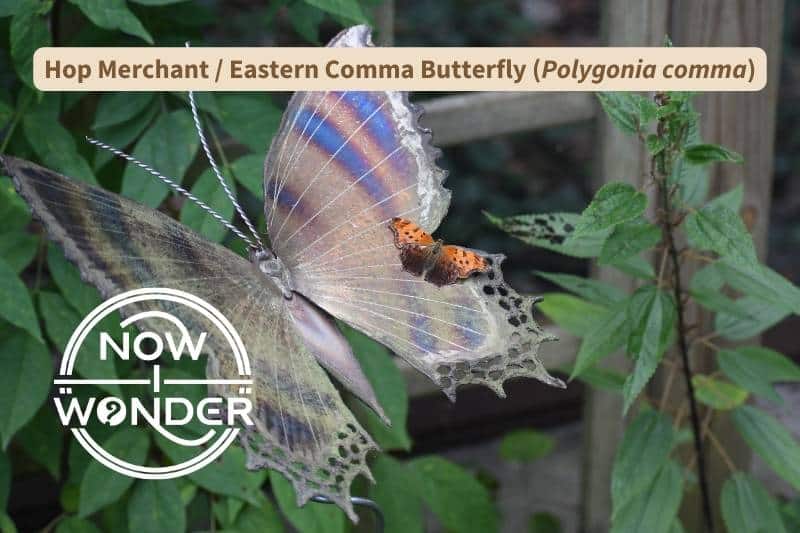
Fun Facts About Hop Merchant Comma Butterflies To Wow Your Friends
- Hop Merchant Comma butterflies are also referred to as “Eastern Commas”, and sometimes as just plain “Commas”.
- Hop Merchant Comma butterflies are an interesting combination of bold and wary.
- They spook easily and hide in trees by perching upside down against the trunk, where their intricate wing patterns and ragged wing edges camouflage them nicely against the bark.
- But adults (especially males) will dart out and fly straight towards interlopers in their vicinity, including other butterflies and even humans before veering off in fast, direct retreat (Pyle, 1981).
- Commas like to bask in the sun and will perch on gravel, sand, and mud. Sometimes they will perch with their wings spread wide. But more often, they open and close their wings in a soothing, regular pattern.
- Hop Merchant Commas can be difficult to differentiate from many of the other species of anglewing butterflies for several reasons:
- The species look similar at first glance.
- Most species are fairly small.
- Distinguishing characteristics are tiny and difficult to spot from a distance.
- Their appearance varies throughout the year, even in the same species.
- Hop Merchant Comma butterflies don’t migrate so live in North Carolina year round.
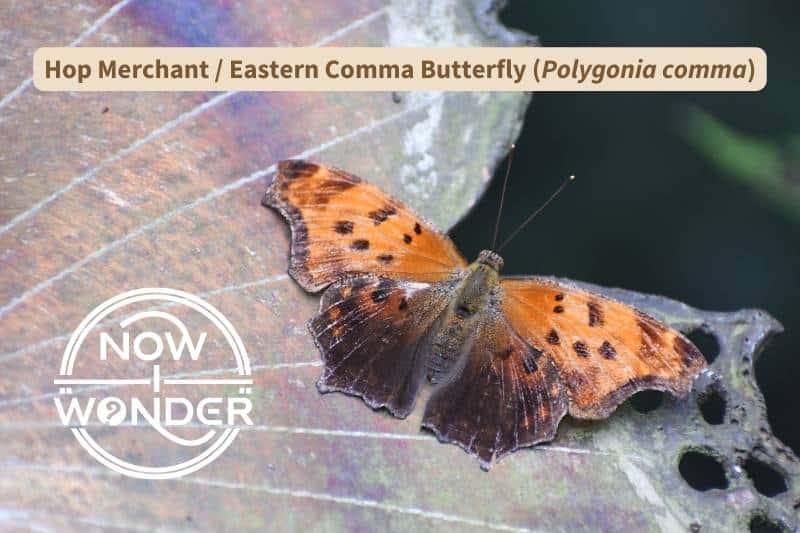
How Are Hop Merchant Comma Butterflies Classified?
| Kingdom | Animalia |
| Phylum | Arthropoda |
| Class | Insects |
| Order | Lepidoptera |
| Family | Nymphalidae (“brushfoots”, subfamily Nymphalinae “true brushfoots) |
| Genus species | Polygonia comma |
How Do I Know I’m Looking at a Hop Merchant Butterfly?
Appearance of Hop Merchant Butterfly Eggs
Hop Merchant Comma eggs are pale green, ribbed and shaped like barrels. Unlike many species of butterflies which spread their eggs one at a time across a host plant’s leaves, female Commas stack their eggs into vertical towers, usually 2-9 eggs at a time (Pyle, 1981).
Appearance of Hop Merchant Butterfly Caterpillars / Larvae
Hop Merchant Comma caterpillars are small, and grow only about an inch (25 mm) long. They can be light green to brown and are covered with black and white spines growing from yellow tubercles. Their brown chrysalises are camouflaged to look like a piece of wood and have a scattering of gold or silver spots along the sides (Pyle, 1981).
Appearance of Adult Hop Merchant Butterflies
Hop Merchant Comma butterflies have brownish-orange, furry bodies with long antennae topped with a bulb. Like all true “brushfoot” butterflies classified in family Nymphalidae their front pair of legs are vestigial and not used for walking or perching; these insects look like they have only four legs.
They grow to wingspans of about 2 inches (51 mm) and the shape of their wings is distinctive. Rather than long, smooth convex curves as seen in other butterfly species, an Eastern Comma’s wing edges are angular, irregular, and cut into in a series of convex curves, which is why these butterflies are sometimes called “anglewings”.
Male and female butterflies look similar; they are mainly orange decorated with many black marking. But their color pattern varies throughout the year. Adult Hop Merchants flying in the summer months are darker overall than butterflies seen in the fall and winter, especially on the upper surface of the hind wings. Winter adults are more orange overall, marked with many black spots.
Each hind wing has a short tail, which helps differentiate Hop Merchants from other angle-wing commas such as the Question Mark (Polygonia interrogationis). The tails on Question Mark butterflies are significantly longer and more obvious.
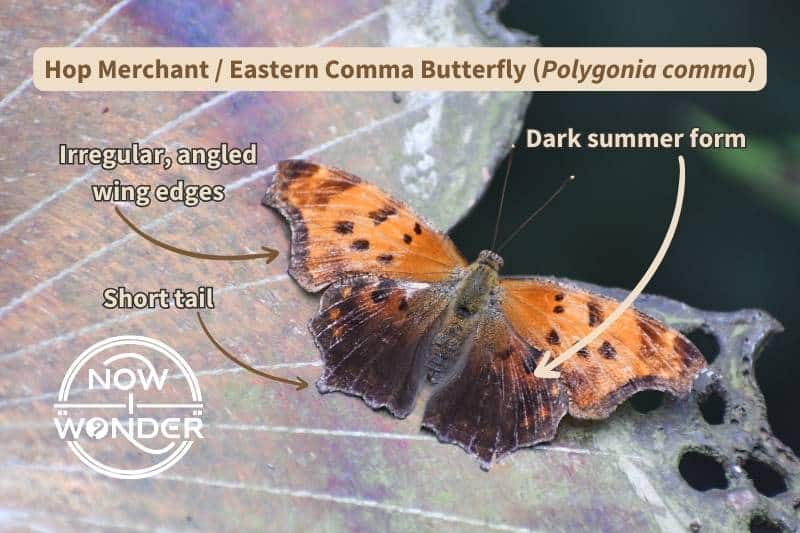
The “comma” portion of Hop Merchant Comma butterflies’ common name comes from a single, thin, curved silver mark on the underside of their hind wings. This mark is tiny but distinctive and looks like the comma punctuation mark.
The rest of the ventral wings are variegated, mottled brown and tan. This coloration, combined with their irregular wing edges, help them hide in plain sight – they just look like dead leaves when they perch or dangle motionless in trees with their wings folded together.
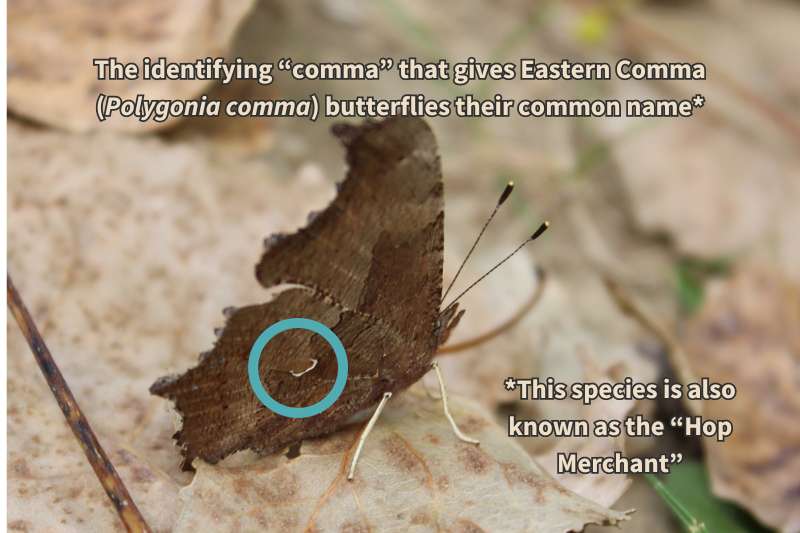
When Can I Find Hop Merchant Comma Butterflies in North Carolina?
In North Carolina, adult Hop Merchant Comma butterflies survive all year; they don’t die off in the fall or migrate like some other butterflies do.
Instead, they survive the winter by hiding from cold temperatures and predators under tree bark and in tree hollows and log piles (Daniels, 2003). They remain still to conserve energy and rely on the fat reserves they built up over their weeks of foraging food during the summer.
Once temperatures rise and spring flowers begin to bloom, they emerge from hiding and immediately begin foraging for food. Because the adults can be active so early in the spring, Hop Merchant Commas can raise multiple broods every summer.
Where Should I Look to Find Hop Merchant Comma Butterflies in North Carolina?
Adult Hop Merchant Comma butterflies live throughout the year in North Carolina but are active mainly in the warmer months only. They emerge from hibernation in early March and fly throughout the fall. Falling nighttime temperatures spur them into hiding for the winter but warm snaps sometimes lure them into emerging temporarily.
They are forest and forest edge butterflies, especially riparian forests (those that grow along rivers, streams, and lakes), but can also be found in habitats near these areas, such as thickets and brushy areas, as well as swamps and marshes.
While Hop Merchant Comma butterflies live throughout North Carolina, they are uncommon. They are also wary by nature and fast fliers who flee perceived threats readily; they like to hide in trees where their “dead-leaf” appearance makes them easy to overlook.
What Do Hop Merchant Comma Butterflies Eat?
Hop Merchant Comma Butterfly Larval Food Plants
Hop Merchant Commas prefer hops plants (Humulus lupulus) (thus one of its common names) and nettles (Urticaria dioica) for food but will also feed on the leaves of elm trees (Ulmaceae).
Adult Hop Merchant Comma Butterfly Food
Unlike many other North Carolina butterflies, Hop Merchant Comma butterflies don’t visit flowers very often. Rather than siphon flower nectar, they feed from rotted fruit, dung, carrion, and tree sap.
References
Daniels, Jaret C. Butterflies of the Carolinas. 2003. Cambridge, MN: Adventure Publications, Inc.
Glassberg, Jeffrey. 2002. Butterflies of North America. Michael Friedman Publishing, Inc.
Opler, Paul A. 1994. Peterson First Field Guide to Butterflies and Moths. Boston, MA: Houghton Mifflin Company.
Pyle, Robert Michael. 1981. National Audubon Society Field Guide to Butterflies: North America. New York, NY: Alfred A. Knopf.


